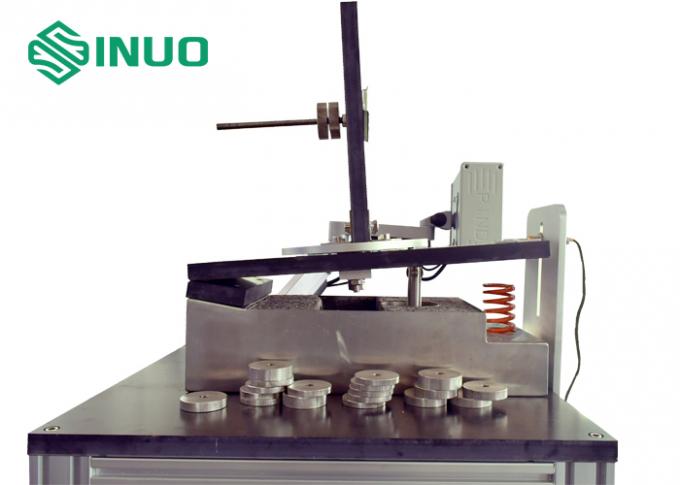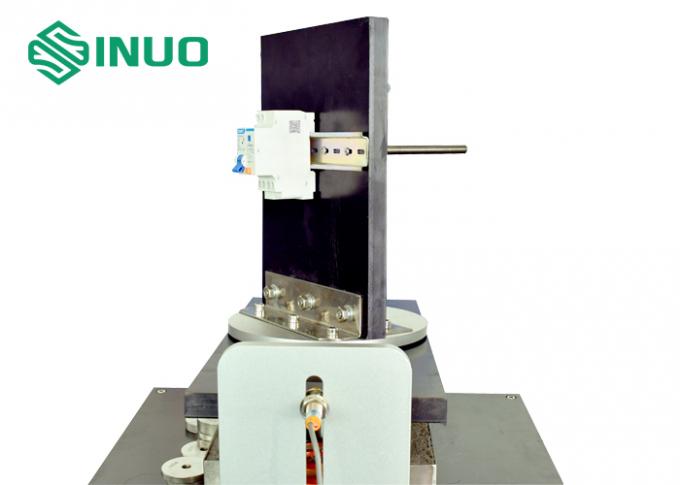

| MOQ: | 1 |
| Price: | Customized |
| Standard Packaging: | Plywood Case |
| Delivery Period: | 30 Days |
| Payment Method: | T/T |
| Supply Capacity: | 10 sets per month |
IEC 60898-1 Mechanical Shock Tester For Circuit Breaker Impact Resistance Testing
Product Information:
The test equipment conforms to the standard requirements of IEC 61009-1:2012, IEC60898-1:2015, etc.
It is used for circuit breaker product testing to verify the impact resistance of exposed parts of circuit breakers that may be subjected to mechanical shocks during normal use.
Test principle: Lift the mounting plate with the circuit breaker through the motor control cam, and instantly drop freely to the metal stop plate equipped with the coil spring with an elastic coefficient of 25N/mm. Reciprocate 50 times in this way, and the sample switches the other three 90-degree directions through the turntable and repeats the test 50 times.
Features: 1. PLC control, touch screen operation, servo motor drive, precise control.
2. The drop height is determined by the eccentric distance of the cam, without deviation.
3. Adopt Yiheda customized elastic coefficient helical spring.
4. The turntable can be rotated 4-90°, which really simulates the impact resistance test of the circuit breaker in all directions.
Technical Parameters:
| Model | SN2506 |
| Test station | Single |
| Electrical control method | PLC intelligent integrated control, man-machine touch interface operation |
| Drive mode | Motor drive mechanism cam |
| Coil Spring | Elastic coefficient 25N/mm |
| Base A, Platform B, Plank C | Hardwood, painted black |
| Drop height | 40mm |
| Turntable | Can be 4-90°rotation fixed |
| Weights | 100g*10pcs, 150g*5pcs, 200g*5pcs |
| Number of tests | 0-999999 times, touch screen preset |
| Load output | 0-999999s, touch screen preset |
| Dimension | 900mm×600mm×1350mm |
| Weight | About 110 KG |
| Power supply | AC380V±10% 50Hz, 1kVA |
Features:
A mechanical shock tester, also known as a shock test machine or shock testing equipment, is a specialized apparatus used to subject products, components, or materials to controlled mechanical shocks or impacts. The purpose of this testing is to evaluate the ability of the test specimen to withstand and resist sudden, high-intensity forces that may occur during transportation, handling, or operational conditions. Here are the key features and functions typically associated with a mechanical shock tester:
Drop or Impact Platform: The mechanical shock tester includes a drop or impact platform where the test specimen is placed for testing. The platform is designed to provide a controlled and repeatable means of delivering mechanical shocks or impacts to the specimen.
Shock Generation Mechanism: The tester incorporates a mechanism to generate shocks or impacts. This mechanism can vary depending on the specific design of the tester and may include methods such as pneumatic systems, spring-loaded mechanisms, or electromagnetic actuators. It allows for precise control over the intensity and duration of the shock or impact.
Acceleration Measurement: The tester is equipped with sensors or accelerometers to measure the acceleration or g-forces experienced by the test specimen during the shock event. These measurements provide quantitative data on the impact severity and allow for the comparison of different test specimens or test conditions.
Shock Pulse Control: Mechanical shock testers often offer control over the shape and duration of the shock pulse. This control allows for the simulation of specific shock profiles or waveforms that mimic real-world scenarios or industry standards. It ensures that the testing accurately represents the expected shock events that the specimen may encounter.
Test Specimen Fixturing: The shock tester incorporates fixtures or mounting mechanisms to securely hold the test specimen in place during testing. These fixtures ensure that the specimen is properly positioned and oriented to receive the desired shock or impact forces.
Safety Features: Safety measures are implemented in mechanical shock testers to protect both the operators and the equipment. These features may include safety enclosures, interlocks, emergency stop buttons, and damping systems to mitigate the effects of the shock waves.
Compliance with Standards: Mechanical shock testers are designed to comply with industry standards and testing protocols, such as those specified by ASTM (American Society for Testing and Materials) or IEC (International Electrotechnical Commission). Compliance ensures that the testing process and results are consistent and comparable across different testing laboratories.
Mechanical shock testers are widely used in various industries, including electronics, automotive, aerospace, and packaging. They help manufacturers assess the durability and reliability of their products under impact conditions, identify weak points or potential failures, and improve product design and packaging to ensure safe transportation and operation.




| MOQ: | 1 |
| Price: | Customized |
| Standard Packaging: | Plywood Case |
| Delivery Period: | 30 Days |
| Payment Method: | T/T |
| Supply Capacity: | 10 sets per month |
IEC 60898-1 Mechanical Shock Tester For Circuit Breaker Impact Resistance Testing
Product Information:
The test equipment conforms to the standard requirements of IEC 61009-1:2012, IEC60898-1:2015, etc.
It is used for circuit breaker product testing to verify the impact resistance of exposed parts of circuit breakers that may be subjected to mechanical shocks during normal use.
Test principle: Lift the mounting plate with the circuit breaker through the motor control cam, and instantly drop freely to the metal stop plate equipped with the coil spring with an elastic coefficient of 25N/mm. Reciprocate 50 times in this way, and the sample switches the other three 90-degree directions through the turntable and repeats the test 50 times.
Features: 1. PLC control, touch screen operation, servo motor drive, precise control.
2. The drop height is determined by the eccentric distance of the cam, without deviation.
3. Adopt Yiheda customized elastic coefficient helical spring.
4. The turntable can be rotated 4-90°, which really simulates the impact resistance test of the circuit breaker in all directions.
Technical Parameters:
| Model | SN2506 |
| Test station | Single |
| Electrical control method | PLC intelligent integrated control, man-machine touch interface operation |
| Drive mode | Motor drive mechanism cam |
| Coil Spring | Elastic coefficient 25N/mm |
| Base A, Platform B, Plank C | Hardwood, painted black |
| Drop height | 40mm |
| Turntable | Can be 4-90°rotation fixed |
| Weights | 100g*10pcs, 150g*5pcs, 200g*5pcs |
| Number of tests | 0-999999 times, touch screen preset |
| Load output | 0-999999s, touch screen preset |
| Dimension | 900mm×600mm×1350mm |
| Weight | About 110 KG |
| Power supply | AC380V±10% 50Hz, 1kVA |
Features:
A mechanical shock tester, also known as a shock test machine or shock testing equipment, is a specialized apparatus used to subject products, components, or materials to controlled mechanical shocks or impacts. The purpose of this testing is to evaluate the ability of the test specimen to withstand and resist sudden, high-intensity forces that may occur during transportation, handling, or operational conditions. Here are the key features and functions typically associated with a mechanical shock tester:
Drop or Impact Platform: The mechanical shock tester includes a drop or impact platform where the test specimen is placed for testing. The platform is designed to provide a controlled and repeatable means of delivering mechanical shocks or impacts to the specimen.
Shock Generation Mechanism: The tester incorporates a mechanism to generate shocks or impacts. This mechanism can vary depending on the specific design of the tester and may include methods such as pneumatic systems, spring-loaded mechanisms, or electromagnetic actuators. It allows for precise control over the intensity and duration of the shock or impact.
Acceleration Measurement: The tester is equipped with sensors or accelerometers to measure the acceleration or g-forces experienced by the test specimen during the shock event. These measurements provide quantitative data on the impact severity and allow for the comparison of different test specimens or test conditions.
Shock Pulse Control: Mechanical shock testers often offer control over the shape and duration of the shock pulse. This control allows for the simulation of specific shock profiles or waveforms that mimic real-world scenarios or industry standards. It ensures that the testing accurately represents the expected shock events that the specimen may encounter.
Test Specimen Fixturing: The shock tester incorporates fixtures or mounting mechanisms to securely hold the test specimen in place during testing. These fixtures ensure that the specimen is properly positioned and oriented to receive the desired shock or impact forces.
Safety Features: Safety measures are implemented in mechanical shock testers to protect both the operators and the equipment. These features may include safety enclosures, interlocks, emergency stop buttons, and damping systems to mitigate the effects of the shock waves.
Compliance with Standards: Mechanical shock testers are designed to comply with industry standards and testing protocols, such as those specified by ASTM (American Society for Testing and Materials) or IEC (International Electrotechnical Commission). Compliance ensures that the testing process and results are consistent and comparable across different testing laboratories.
Mechanical shock testers are widely used in various industries, including electronics, automotive, aerospace, and packaging. They help manufacturers assess the durability and reliability of their products under impact conditions, identify weak points or potential failures, and improve product design and packaging to ensure safe transportation and operation.


